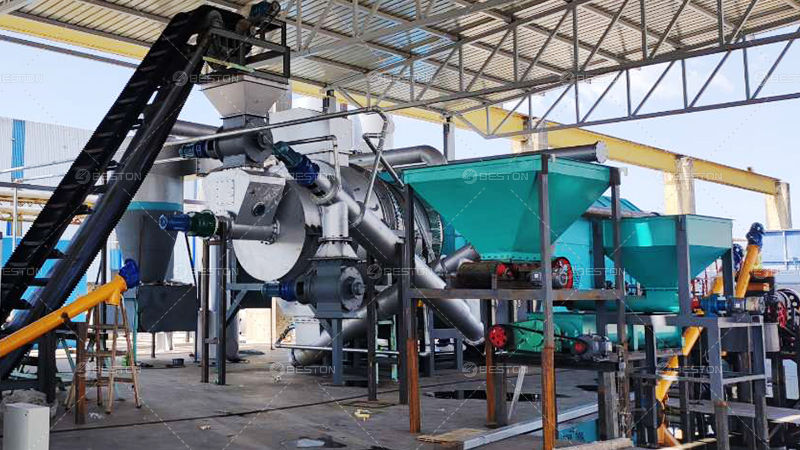Leveraging Palm Biomass for Profitable Charcoal Ventures
- arbourz
- Jun 17
- 3 min read
Palm oil cultivation generates massive streams of lignocellulosic waste—empty fruit bunches (EFB), fronds, trunks, and kernel shells. Traditionally underutilized or openly burned, these residues can be transformed into high‑value charcoal through controlled pyrolysis. Strategic deployment of a charcoal machine at mill or plantation level unlocks diversified revenue channels, aligns with sustainability mandates, and mitigates waste‑handling liabilities.
Abundant Feedstock and Logistics Synergy
Southeast Asia alone processes more than 250 million tonnes of fresh fruit bunches annually, yielding roughly 30 percent by‑weight lignocellulosic residue. Kernel shells and EFB exhibit favorable fixed‑carbon content—up to 45 percent—making them prime inputs for carbonization machine. Because residues are concentrated at palm mills, feedstock collection costs are minimal, and existing in‑house material handling systems—conveyors, shredders, loaders—readily integrate with continuous‑feed pyrolysis units.
High‑Grade Charcoal Outputs
Palm kernel shell charcoal delivers calorific values exceeding 7,200 kcal kg⁻¹ and ash content below 3 percent, outperforming many hardwood equivalents. These metrics position it for industrial and household fuel markets, barbecue briquette production, and metallurgical reductant applications. EFB‑derived biochar, though lower in density, offers high porosity suitable for soil enhancement and activated carbon precursors.
Product diversification mitigates price volatility across commodity segments. For example, lump charcoal targets premium grilling markets, while powdered fractions are agglomerated into briquettes or granulated for water filtration media.

Energy Self‑Sufficiency Through Syngas Utilization
A modern palm charcoal maker machine recycles non‑condensable gases generated during pyrolysis to sustain reactor temperatures, reducing or eliminating fossil fuel use. Surplus thermal energy can be channeled into palm oil mill operations—such as kernel drying or steam generation—lowering utility costs and improving overall energy efficiency indices.
Carbon Finance and Environmental Compliance
Biochar produced from palm residues offers long‑term carbon sequestration potential. Projects validated under the European Biochar Certificate (EBC) or Verra methodologies can monetize removal credits, currently trading at USD 80–120 per tonne of CO₂‑equivalent. Additionally, diverting biomass from open burning or decomposition curtails methane and particulate emissions, aiding compliance with both national air‑quality regulations and corporate ESG targets.
Economic Metrics and ROI
Capital expenditure for a mid‑scale installation—processing 2 tonnes h⁻¹ of kernel shell—typically ranges from USD 1.5 million to USD 2.5 million, inclusive of emission control and briquetting modules. Operating expenses remain modest due to low or negative feedstock costs, labor efficiencies, and in‑process energy recovery.
Revenue streams include:
Bulk charcoal sales: USD 280–350 t⁻¹ FOB, depending on specification
Activated carbon precursors: premium pricing up to USD 1,000 t⁻¹ post‑activation
Carbon credits: 2.5–3.0 t CO₂‑e captured per tonne of biochar
Heat and power offset: 10–15 % reduction in mill fuel expenditure
Under conservative uptake forecasts, payback periods fall within 24–30 months, with internal rates of return surpassing 20 percent in most Southeast Asian jurisdictions.
Regulatory Incentives and Market Access
Indonesia’s mandatory “No Burn” policy and Malaysia’s decarbonization roadmap encourage biomass valorization. Incentive packages include import duty exemptions for clean‑tech machinery and preferred loan rates from green financing programs. Export demand remains strong in Middle Eastern shisha charcoal markets and European barbecue segments, both seeking sustainable alternatives to tropical hardwood.
Integration Models and Scalability
Two deployment pathways dominate:
Mill‑Integrated UnitsStationary systems co‑located with oil mills leverage existing utilities, land permits, and skilled technicians. They process steady shell and EFB streams, supplying both local energy and export‑grade charcoal.
Mobile or Modular SkidsTrailer‑mounted kilns service satellite plantations with variable residue volumes. These decentralized units aggregate biomass within a 30‑km radius, reducing transport back‑haul and enabling flexible scale‑up.
Both configurations benefit from remote monitoring, PLC‑based temperature control, and automated feed to maintain consistent product specifications.
Strategic Outlook
Growing consumer preference for sustainable grilling fuels, tightening land‑application rules for palm waste, and robust carbon markets create formidable momentum for charcoal ventures in the palm sector. Enterprises that integrate advanced pyrolysis technology, secure offtake agreements, and capitalize on carbon finance stand poised to convert an abundant residue stream into a diversified profit engine—driving both economic gain and environmental stewardship across palm‑growing regions.









Comments